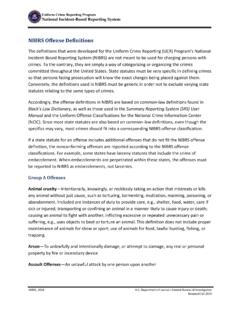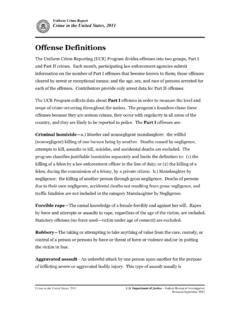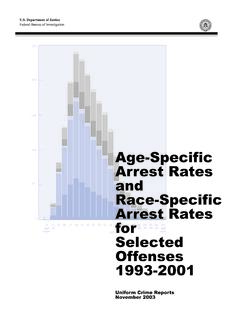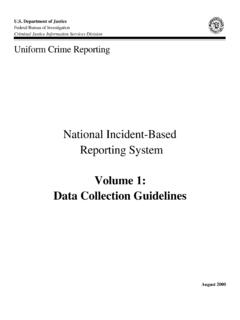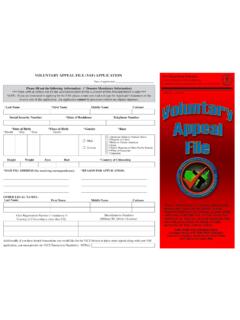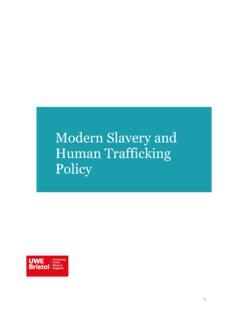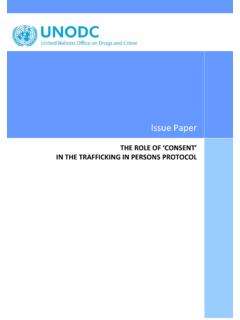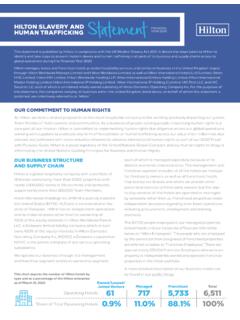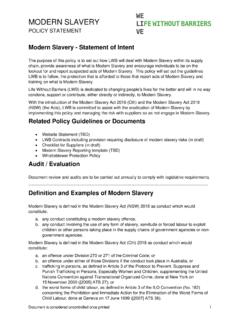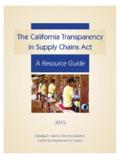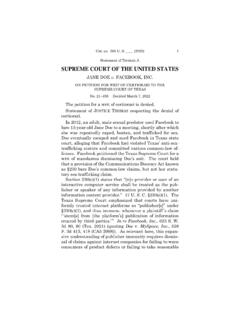Transcription of Human Trafficking, 2019 - Federal Bureau of Investigation
1 Human trafficking , 2019, is the seventh report from the national Uniform Crime Reporting (UCR) Program s Human trafficking data collection. Forty-eight (48) states and the territory of Puerto Rico participated. The 2019 report shows a total of 1,883 incidents of Human trafficking were reported: 1,607 were in the category of commercial sex acts, and 274 were instances of involuntary servitude. (Puerto Rico submitted two incidents in the Total column and did not specify whether those incidents were under the category of commercial sex acts or involuntary servitude.) Agencies arrested 708 offenders in correlation with these incidents. Of these, 684 were adults and 24 were juveniles. Participation Since its inception in 2013, the FBI s Human trafficking data collection has, for the most part, seen a steady increase in state participation as well as an increase in the number of incidents reported. The program will continue efforts to expand, gather, and make available information regarding Human trafficking incidents.
2 trafficking Victims Protection Act In January 2013, the national UCR Program began collecting offense and arrest data regarding Human trafficking as authorized by the William Wilberforce trafficking Victims Protection Reauthorization Act of 2008. The act requires the FBI to collect Human trafficking offense data and to make distinctions between prostitution, assisting or promoting prostitution, and purchasing prostitution. To comply with the Wilberforce Act, the national UCR Program created two additional offenses in the Summary Reporting System (SRS) and the National Incident-Based Reporting System (NIBRS) through which the UCR Program collects both offense and arrest data. The definitions for these offenses are: Human trafficking /Commercial Sex Acts: inducing a person by force, fraud, or coercion to participate in commercial sex acts, or in which the person induced to perform such act(s) has not attained 18 years of age.
3 Human trafficking /Involuntary Servitude: obtaining of a person(s) through recruitment, harboring, transportation, or provision, and subjecting such persons by force, fraud, or coercion into involuntary servitude, peonage, debt bondage, or slavery (not to include commercial sex acts). The data in the tables included in this report reflect the offenses and arrests recorded by state and local law enforcement agencies that currently have the ability to report the data to the national UCR Program. As such, they should not be interpreted as a definitive statement of the level or characteristics of Human trafficking as a whole. The data declaration pages, which will help the user better understand the data, and the methodology used for the four following tables are located in the Data Declarations and Methodology section of this report. In addition, a Questions and Answers section about Human trafficking data is provided as a supplement to this report.
4 *Guam participated in the data collection in 2014, 2015, and 2017.*Puerto Rico participated in the data collection from 2015 to 2019.*The Virgin Islands participated in the data collection from 2014 to trafficking , 2019 Note: Regarding the data reported to the UCR Program, it is important to note that these data represent only one view of a complex issue the law enforcement perspective. However, due to the nature of Human trafficking , many of these crimes are never reported to the local, state, tribal, and Federal law enforcement agencies that investigate them. In addition to the law enforcement facet in fighting these crimes, there are victim service organizations whose mission it is to serve the needs of the victims of Human trafficking . In order to have the complete picture of Human trafficking , it would be necessary to gather information from all these sources. Download Excel file of Table 1, Human trafficking , Offenses and Clearances by State, 2019 Download Excel file of Table 2, Human trafficking Arrests, by Age by State, 2019 Download Excel file of Table 3, Human trafficking Arrests, by Race by State, 2019 Download Excel file of Table 4, Human trafficking Arrests, by Ethnicity by State, 2019 Data Declarations and Methodology Human trafficking Table 1 Offenses and Clearances by State, 2019 The FBI collects these data through the Uniform Crime Reporting (UCR) Program s Summary Reporting System and National Incident-Based Reporting System.
5 General Comment This table includes the states that have added Human trafficking offenses to their data collection. Even though a state program included Human trafficking , the individual agencies in that state may or may not have added it to their collections. Portions of Mississippi and Ohio do not have a state UCR program to manage the collection of UCR data within the state. Each law enforcement agency is responsible for reporting its crime data directly to the FBI. This table provides the volume of Human trafficking offenses as reported by state. For UCR purposes, juveniles are individuals under the age of 18 years. Adults are 18 years of age or older. Methodology The data used in creating this table were from law enforcement agencies submitting one or more Human trafficking incidents for at least 1 month of the calendar year. Also included are zero incident data for states that have incorporated Human trafficking offenses in their data collection where no 2019 Human trafficking incidents were reported to the FBI s UCR Program.
6 The published data, therefore, do not necessarily represent reports from each participating agency for all 12 months of the calendar year. When the FBI determines an agency s data collection methodology does not comply with national UCR guidelines, the figure(s) for that agency s offense(s) will not be included in the table, and the discrepancy will be explained in a footnote. Human trafficking Table 2 by Age by State, 2019 The FBI collects these data through the Uniform Crime Reporting (UCR) Program s Summary Reporting System and National Incident-Based Reporting System. General Comment This table provides the number of juvenile and adult male and female persons arrested for Human trafficking offenses by state in 2019. These data represent the number of persons arrested; however, some persons may be arrested more than once during a year. Therefore, the statistic in this table could, in some cases, represent multiple arrests of the same person.
7 For UCR purposes, juveniles are individuals under the age of 18 years. Adults are 18 years of age and older. Methodology The data used in creating this table were from law enforcement agencies submitting one or more Human trafficking arrests for at least 1 month of the calendar year. The published data, therefore, do not necessarily represent reports from each participating agency for all 12 months of the calendar year. Human trafficking Table 3 by Race by State, 2019 The FBI collects these data through the Uniform Crime Reporting (UCR) Program s Summary Reporting System and National Incident-Based Reporting System. General Comment This table provides the number of persons arrested for Human trafficking offenses by state in 2019 broken down by race of the arrestee. These data represent the number of persons arrested; however, some persons may be arrested more than once during a year. Therefore, the statistics in this table could, in some cases, represent multiple arrests of the same person.
8 For UCR purposes, juveniles are under the age of 18 years. Adults are 18 years of age and older. Methodology The data used in creating this table were from law enforcement agencies submitting one or more Human trafficking arrests for at least 1 month of the calendar year. The published data, therefore, do not necessarily represent reports from each participating agency for all 12 months of the calendar year. Human trafficking Table 4 by Ethnicity by State, 2019 The FBI collects these data through the Uniform Crime Reporting (UCR) Program s Summary Reporting System and National Incident-Based Reporting System. General Comment This table provides the number of persons arrested for Human trafficking offenses by state in 2019 broken down by ethnicity of the arrestee. These data represent the number of persons arrested; however, some persons may be arrested more than once during a year. Therefore, the statistics in this table could, in some cases, represent multiple arrests of the same person.
9 For UCR purposes, juveniles are individuals under the age of 18 years. Adults are 18 years of age and older. Methodology The data used in creating this table were from law enforcement agencies submitting one or more Human trafficking arrests for at least 1 month of the calendar year. The published data, therefore, do not necessarily represent reports from each participating agency for all 12 months of the calendar year. Human trafficking , 2019 Questions and Answers Q: How long has Human trafficking data been collected? A: The Uniform Crime Reporting (UCR) Program began collecting Human trafficking data in January 2013. Q: What does it mean for an offense to be cleared? A: An offense can be cleared by arrest or exceptional means. An offense is cleared by arrest, or solved for crime reporting purposes, when at least one person is (1) arrested, (2) charged with the commission of the offense, and (3) turned over to the court for prosecution.
10 If an agency can answer all the following questions in the affirmative, it can clear the offense exceptionally. 1. Has the Investigation definitely established the identity of the offender? 2. Is there enough information to support an arrest, charge, and turning over to the court for prosecution? 3. Is the exact location of the offender known so that the subject could be taken into custody now? 4. Is there some reason outside law enforcement control that precludes arresting, charging, and prosecuting the offender? Generally, an offense can be exceptionally cleared when it falls into one of the following categories. (This list is not all-inclusive.) 1. Death of the offender. 2. Offender is prosecuted by state or local authorities in another city for a different offense or is prosecuted in another city or state by the Federal government for an offense which may be the same. 3. Extradition denied/In the custody of other jurisdiction.
